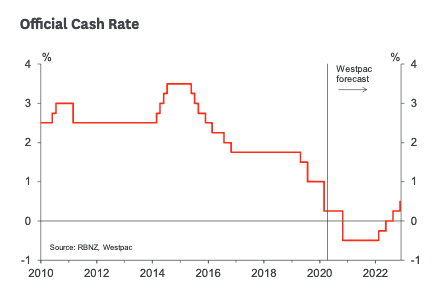New Zealand Dollar Gains to be Severely Limited by Prospect of RBNZ Rates Being Cut into Negative Territory
- RBNZ to introduce negative interest rates
- 'Lower bound' in NZ lower than in other countries
- -ve interest rates could weigh on NZD's recovery potential

Image © Adobe Stock
- GBP/NZD spot rate at time of writing: 2.0647
- Bank transfer rates (indicative guide): 1.9915-2.0059
- FX specialist rates (indicative guide): 1.9999-2.0450 >> more information
The Reserve Bank of New Zealand is expected to cut interest rates deep into negative territory in 2020, an outcome that would severely dent the New Zealand Dollar's appreciation potential.
According to analysis from New Zealand and Australian lender Westpac, the scale of the economic downturn facing New Zealand will prompt the announcement of further measures to support the economy by both the RBNZ and New Zealand government.
Westpac have this week updated their in-house forecasts to account for more Covid-19 information, saying they now expect annual GDP to drop 6.3% in 2020, and to rebound by only 4.3% in 2021.
"Such a weak economic outlook will require a massive monetary and fiscal response," says Dominick Stephens, Chief Economist at Westpac in Auckland.
The forecasts by Westpac comes as New Zealand eases some lockdown restrictions as the spread of covid-19 is deemed to now be contained, which should allow the economy to start recovering.
However, Westpac now expect a deeper decline in June quarter GDP of 16%, "because the Alert Level 3 restrictions are tighter than we previously allowed for," says Stephens.
The sharper-than-expected slump in the June quarter will illicit another fiscal response from the government and Westpac expect the Government will announce roughly $15bn of additional fiscal stimulus at the May budget.
"But more will be required," says Stephens, "we expect the RBNZ will reduce the OCR to -0.5% in November 2020."
Image courtesy of Westpac
Cutting interest rates into negative territory will have potentially significant implications for the value of the New Zealand Dollar, as textbook foreign exchange theory suggests a currency tends to fall when its central bank cuts interest rates.
But, with most global central banks slashing rates to rock-bottom, recent rate cuts at the RBNZ that have taken the OCR to 0.25% have had a potentially minor impact on the NZ Dollar.
However should the RBNZ step up the cuts and go deeper and harder than its peers, then the effect on the New Zealand Dollar could become more profound.
"Speculation of RBNZ exploring negative rate and diary prices suffering from their correlation with crude oil, mean NZD is set to keep lagging AUD," says Chris Turner, Global Head of Markets and Regional Head of Research for UK & CEE at ING Bank N.V.
Negative interest rates at the RBNZ would mark an incredible turn in fortunes for the New Zealand Dollar from an interest rate perspective: for many years New Zealand has commanded one of the highest interest rates in the world, which attracted substantial flows of international money as investors sought out a higher return on their capital.
This inflow of capital proved to be a substantial source of support for the New Zealand Dollar during this time, but it now appears that interest rates could in fact start to work against the New Zealand Dollar.
It could become possible that the NZ Dollar becomes a funding currency, i.e. investors borrow in cheap New Zealand Dollars and export their capital to other jurisdictions where returns are higher.
Such an outcome would potentially create strong downward pressures for the NZ Dollar.
"The timing is uncertain and depends mainly when the trading banks’ systems will be ready to deal with a negative OCR. This move could be telegraphed as early as August, leading to a fall in swap rates at that point," says Stephens.
And, Westpac believe the RBNZ can cut interest rates even lower than -0.5%.
"We estimate that, in New Zealand, the OCR could go down to -1% before further cuts had zero impact on retail rates. This effective lower bound is lower in New Zealand than in many other countries, because in New Zealand bank deposit rates are higher relative to the OCR," says Stephens.
"The lower the OCR goes, the less marginal impact it would have on retail rates such as mortgage rates. Thus a 75 basis point cut from 0.25% to -0.50% would bring mortgage rates down, but not by anything like as much as 75 basis points," adds Stephens.
Other Westpac economic forecasts:
- Government debt will rise to 50% of GDP by 2024.
– Unemployment will peak at 9.5%, slow return to below 5%.
– New Zealand house prices will fall 7% in 2020, to remain subdued throughout 2021.
- House prices "will rise very rapidly over 2022 and 2023 in response to ultra-low interest rates"






